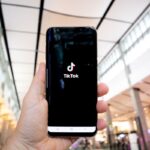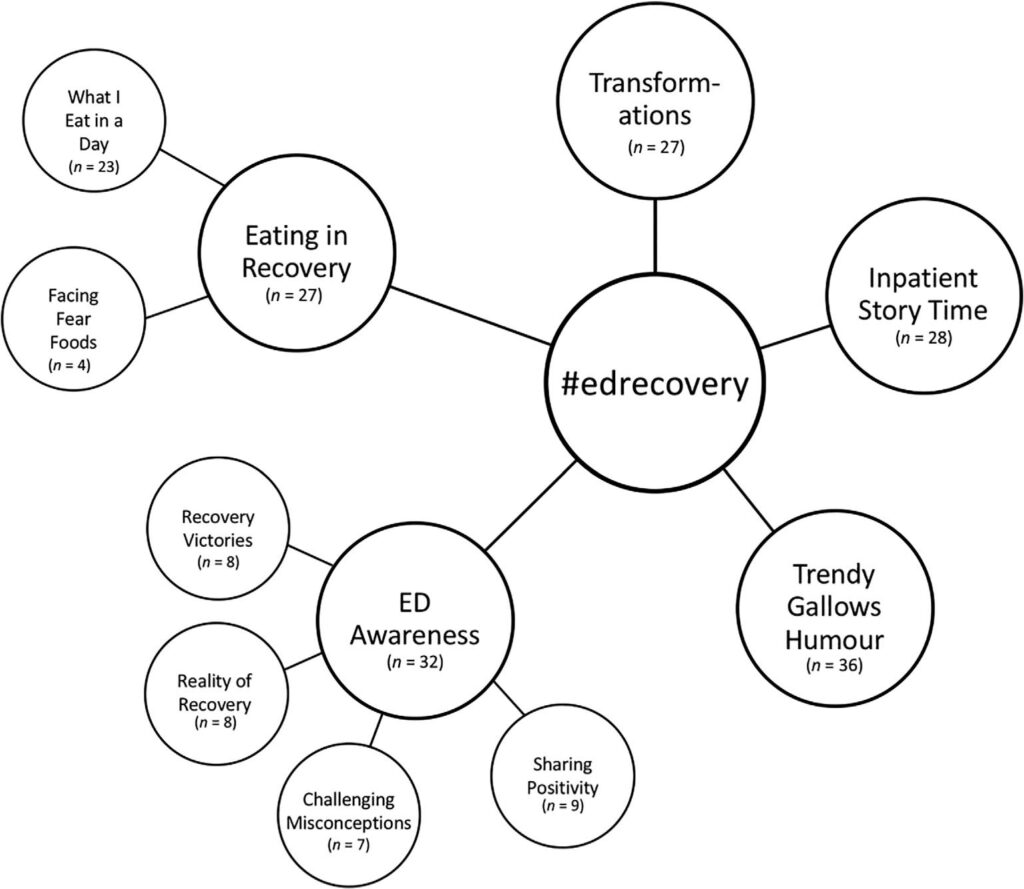
Social media is commonplace in our daily lives and can used to share and discuss content. It has also been used to share and discuss content related to eating disorders (Derenne & Beresin, 2018; Moessner et al, 2018). Indeed, a link has been reported in young females between viewing online pro-eating disorder content and engaging in disordered eating (Jett et al, 2010; Rodgers et al, 2016).
Online eating disorder recovery communities have been found on Instagram (Santarossa et al, 2019), Twitter (Branley & Covey, 2017) and online forums (Kenny et al, 2019), but have yet to be explored on TikTok. TikTok is a free social media app that allows users to watch, create and share short videos (15 seconds or 60 seconds).
Eating disorder recovery on TikTok is often overshadowed by pro-eating disorder content, but the authors question whether there is potential for this platform to be used as a tool to assist in recovery. The research question in this study is “how are TikTok users expressing their personal experiences with eating disorder (ED) recovery through content posted under the hashtag #EDrecovery?”.

Social media can be used to raise awareness about eating disorders to the broader online community and challenge sociocultural norms that promote thinness and unrealistic ideals.
Methods
A systematic review and inductive thematic analysis (Braun et al, 2016) of 150 TikTok posts catalogued under hashtag #EDrecovery was undertaken. The hashtag “#EDrecovery” is the most popular hashtag related to ED recovery with 454.5 million views as of June 2020. Two coders independently analysed the posts and a critical peer facilitated discussions about the resulting codes and themes.
Results
There were five key themes identified from the data (Figure 1). The themes were presented in descending order; from posts that were perceived to be the most connected with ED recovery to posts that were perceived to deviate from ED recovery content.

Figure 1. Themes identified across content posted under #EDrecovery on TikTok. [View full-size image]
1. Eating disorder awareness
21.3% of creators (n=32 posts) shared different aspects of recovery to encourage an enhanced understanding of recovery and eating disorders, which were reflected by four subthemes:
- Recovery victories: creators (n = 8 posts) shared personal triumps in relation to their eating disorder recovery like finishing meals, smashing scales, or getting discharged from inpatient hospitals.
- Reality of recovery: creators (n = 8 posts) showed the challenges and set-backs people can experience during recovery, to avoid social media being solely a “highlight reel” diusplaying positive vontent only (e.g. Weinstein, 2017).
- Challenging misconceptions: creators (n = 7 posts) addressed and challenged common misconceptions associated with eating disorders. One way in which this was achieved was through the ‘one shot rant’ where creators deliver a passionate monologue.
- Sharing positivity: creators (n = 9 posts) provided followers with positive and motivational messages addressed to those who may be struggling with their eating disorder or recovery.
2. Inpatient story time
Some creators created videos to share their experiences as an inpatient, often using a comedic approach (18.7%; n = 28). Some inpatient stories detailed getting in trouble for laughing too hard because it was “too much physical exertion”, being denied a food request because it was a “weird food combination”, and how staff interrupted showers because they thought patients were exercising.
3. Eating in recovery
Some creators (n = 27; 18.0%) shared thteir journeys adapting to eating in recovery. This included the two subthemes: (a) What I eat in a day and (b) Facing fear foods. Sharing “what I eat in a day” is common across social media and #EDrecovery creators co-opted this trend to document their food at different stages of recovery. Some TikToks (2.7%; n = 4) also showed creators eating and facing fear foods (i.e., foods they are afraid to eat or have had negative experiences with; Albers, 2011).
4. Transformations
Demonstrating a positive change or “glow up” is common across TikTok (18.0%; n = 27). This is commonly used to celebrate weight loss transformations but creators under #EDrecovery used it to celebrate their own recovery and weight gain.
5. Trendy gallows humour
Gallows humour (24.0% of posts; n = 36) was used to add a comedic spin to dangerous, scary or potentially life-threatening situations. This included videos intended to “confuse people who have a normal relationship with food.” Creators showed images of rice crackers, gum, ice cubes, measuring their waist and wrists, the logo for MyFitnessPal (an application for tracking food intake, weight loss, and exercise), and screenshots of online BMI calculators.

Creators on TikTok used #EDrecovery to share their personal experiences with recovery through the use and co-option of popular (or viral) video formats, succinct storytelling, and the production of educational content.
Conclusions
This study explored content related to eating disorder recovery (#EDrecovery) on TikTok. Creators on TikTok expressed their personal experiences of eating disorders through the use and co-option of trendy video formats, succinct storytelling, and the production of education content. There was some content not related to recovery from eating disorders (e.g., trendy gallows humour) that may be potentially harmful or triggering to those exploring #EDrecovery on TikTok. There was variation in the narrative regarding “full recovery” versus “struggling with recovery” the authors noted this may “be a reflection of how creators perceive and/or personally define ED recovery (Shohet, 2007, 2018).”

TikTok as a user-friendly, creative media may provide the artistic and social tools for some creators to add their distinct voice to the ED recovery narrative and foster some semblance of community.
Strengths and limitations
This study has taken steps forwards to understanding the impact of TikTok, a relatively new social media platform, particularly in the context of eating disorders where there is a concern that these may feature pro anorexia (#proana) content.
Understanding how young people communicate and consume media can help identify or reach out to those who may benefit from online or in-person support.
The posts analysed in this study may not display the most popular or recent TikToks due to the algorithms used to display hashtags on TikTok. As the study TikTok did not previously engage with any posts, a default or “normative” display may have been presented.
TikTok has a geographic component, displaying content tailored to the user’s location, thence the data in this study is likely from North America (due to the location of the study authors). This may depict recovery from a predominantly Western perspective.
An English hashtag was used for analysis which restricts posts from non-English speaking creators.
The TikToks were also created by mainly young, white, female or female-presenting creators, which is a fairly homogenous sample and reinforces stereotypical demographics associated with eating disorders.
There are ethical considerations regarding collecting data in this way, the creators did not know that their posts would be used in a research study, but did publish their content in a way which allowed it to be shared across platforms and downloaded.

This study noted that some eating disorder (ED) recovery content on TikTok can be positive, giving a voice to those with eating disorders to share their experiences and recovery, but this may reflect predominantly Western perspectives.
Implications for practice
The authors recommend that, rather than censoring all online content related to eating disorders, personal experiences of struggle and recovery should be encouraged and amplified (Kenny et al, 2019; Wolf, Theis & Kordy, 2013). Social media can have positive uses and this needs to be explored and promoted as a way of connecting people with shared experiences, online support and identifying users that could benefit from being guided towards resources or treatment options (Branley & Covey, 2017).
Health professionals who provide care for patients with eating disorders should be aware of the content users may be exposed to on social media platforms, in order to have educated conversations on the potential negative consequences of viewing pro-ED content online (Branley & Covey, 2017), as well as recognising the positives such as sharing stories of resilience and ED recovery.
Also, by incorporating new creative technologies that are socially relevant to adolescents, patients may be more likely to continually express and share their experiences after their treatment has ended.
Future research should explore how social media platforms can be used to normalise a multiplicity of experiences with eating disorders, spread eating disorder awareness and build a supportive online community for eating disorder recovery.

Increasing awareness of what young people engage with online, can aid health professionals’ understanding of the impacts of this and how to approach the topic with young people.
Statement of interests
The author reports no conflicts of interest.
Links
Primary paper
Herrick, Shannon SC, Laura Hallward, and Lindsay R. Duncan. “This is just how I cope”: An inductive thematic analysis of eating disorder recovery content created and shared on TikTok using# EDrecovery.” International Journal of Eating Disorders (2020).
Other references
Albers, Susan. “Using mindful eating to treat food restriction: A case study.” Eating Disorders 19.1 (2010): 97-107.
Branley, Dawn B., and Judith Covey. “Pro-ana versus pro-recovery: A content analytic comparison of social media users’ communication about eating disorders on Twitter and Tumblr.” Frontiers in psychology 8 (2017): 1356.
Braun, Virginia, Victoria Clarke, and Paul Weate. “Using thematic analysis in sport and exercise research.” Routledge handbook of qualitative research in sport and exercise (2016): 191-205.
Derenne, Jennifer L., and Eugene V. Beresin. “Body image, media, and eating disorders.” Academic psychiatry 30.3 (2006): 257-261.
Kenny, Therese E., Sarah L. Boyle, and Stephen P. Lewis. “# recovery: Understanding recovery from the lens of recovery‐focused blogs posted by individuals with lived experience.” International Journal of Eating Disorders 53.8 (2020): 1234-1243.
Moessner, Markus, et al. “Analyzing big data in social media: Text and network analyses of an eating disorder forum.” International Journal of Eating Disorders 51.7 (2018): 656-667.
Santarossa, Sara, et al. “# Orthorexia on Instagram: a descriptive study exploring the online conversation and community using the Netlytic software.” Eating and Weight Disorders-Studies on Anorexia, Bulimia and Obesity 24.2 (2019): 283-290.
Shohet, Merav. “Narrating Anorexia:” full” and” struggling” genres of recovery.” Ethos 35.3 (2007): 344-382.
Shohet, Merav. “Beyond the clinic? Eluding a medical diagnosis of anorexia through narrative.” Transcultural Psychiatry 55.4 (2018): 495-515.
Weinstein, Emily. “Adolescents’ differential responses to social media browsing: Exploring causes and consequences for intervention.” Computers in Human Behavior 76 (2017): 396-405.
Wolf, Markus, Florian Theis, and Hans Kordy. “Language use in eating disorder blogs: Psychological implications of social online activity.” Journal of Language and Social Psychology 32.2 (2013): 212-226.
Photo credits
- Herrick, Shannon SC, Laura Hallward, and Lindsay R. Duncan. “This is just how I cope”: An inductive thematic analysis of eating disorder recovery content created and shared on TikTok using# EDrecovery.” International Journal of Eating Disorders (2020).
- Photo by Olivier Bergeron on Unsplash
- Photo by ROBIN WORRALL on Unsplash
- Photo by Jakob Owens on Unsplash
- Photo by Kelly Sikkema on Unsplash
- Photo by Juliana Kozoski on Unsplash
- Photo by Meghan Schiereck on Unsplash
